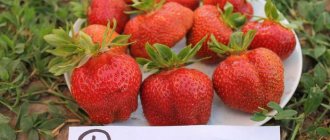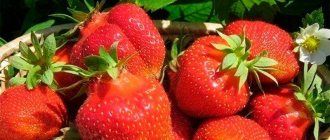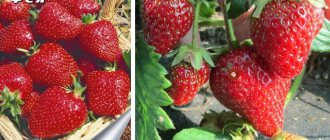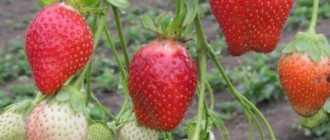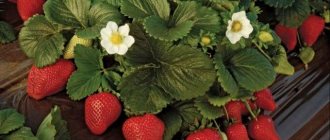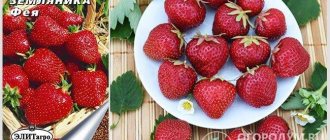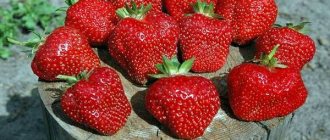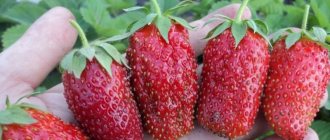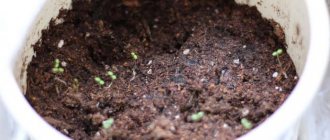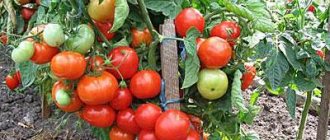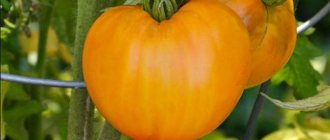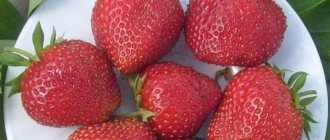There are varieties of strawberries that are equally good both for planting in a garden plot for personal consumption and for cultivation on farm plantations on an industrial scale. These varieties include Syrian strawberries - the fruit of many years of work by Italian breeders. Shows excellent results in continental climates and is successfully grown in many regions of Russia.
Description of the variety
Strawberry Syria is a non-repairing mid-season variety (the beginning of fruiting is about a week later than another popular strawberry variety - Alba). Gardeners are attracted primarily by the unpretentiousness of growing conditions and the possibility of obtaining a fragrant, sweet harvest, albeit not the largest.
Syria belongs to the intensive promising varieties. Among the “Italians”, the following varieties can be included in the same group: Asia, Alba, Roxana.
Bushes
Syria strawberry bushes are powerful, medium-sized, medium-leafed, with large dark green, shiny, slightly wrinkled leaves.
A distinctive feature of Syria is that the edges of the leaves bend downwards
With this structure of the plant, the fruits are hidden from the bite of birds among the leaves. A large number of medium-sized white flowers are formed on powerful peduncles.
On the recommendation of Italian breeders, Syria is left for the third fruiting, after which the plantation is renewed. For most modern varieties, a change after the second fruiting is recommended.
Berries
The fruits of Syria in the first wave of ripening are large, weighing 40-60 g. The last berries are almost twice as small - about 25 g. The shape is beautiful - regular conical, without ribbing. The density is moderate, sufficient to transport and store the crop for a long time without compromising quality.
At the stage of biological ripeness, the color of the berries is bright red with a cherry tint. The cut is light pink, has no voids or annoying white streaks. The yellowish seeds are slightly pressed into the pulp. The aroma is complex, long-lasting, with notes of garden strawberries and flowering fruit trees.
The taste harmoniously combines sweetness and sourness; these qualities are not lost during storage. Professional tasters rated Syrian strawberries 4.5 points out of 5. Even unripe berries with a green tip taste sweet.
Productivity
Powerful peduncles hold well a bountiful harvest of ripe berries, which increases in the second and third years without loss of varietal characteristics. On industrial plantations with a density of 50 thousand bushes per 1 hectare, more than 200 centners are obtained. On personal plots, gardeners remove up to 500-900 g from one plant.
Aftercare
Syrian strawberries need quality care throughout the growing season.
List of recommended care measures:
- Preventive treatment of strawberry plantations against diseases and pests. Carry out in the spring using biological products. Fitosporin and Gupsin are highly effective.
- Timely and sufficient watering, which should be carried out based on the condition of the soil and the stage of vegetative development of plants (flowering, fruiting).
- Mulching plantings in spring.
- Loosening the soil after watering.
- Removing weeds.
- Feeding plants with organic and mineral fertilizers. It is recommended to carry out it in 4 stages - immediately after planting or the appearance of leaves, during the formation of ovaries, after harvesting, before wintering.
Attention! It is more advisable to water strawberries using drip irrigation. In its absence, strawberry plantations should be watered exclusively in the morning or evening, after the heat has subsided. The water temperature must be at least 15 °C.
Preparing for winter
After fruiting, Syrian strawberries need care, namely preparation for winter. Timely preparations are the key to a good harvest next season. In autumn it is recommended:
- Apply complex mineral fertilizer to the soil.
- Cover the bushes with hay, straw, branches or special covering material.
a brief description of
Strawberry Syria is a universal variety and has advantages that allow us to talk about commercial success in growing this crop.
Advantages of the variety
- high tasting assessment of the taste characteristics of the fruit;
- suitable for fresh consumption, in compotes, does not lose its shape after defrosting;
- good adaptive capabilities to different climatic conditions;
- high winter hardiness;
- The quality and quantity of the harvest is not affected by heat and short-term drought, the fruits are not baked in the sun;
- excellent transportability of berries, which can be transported over long distances and stored for a long time;
- resistance to the most common fungal diseases and mites;
- not chlorositis.
Disadvantages of the variety
- does not belong to the record holders for yield;
- when grown in greenhouses, it is susceptible to spider mites.
Average yield characteristics are compensated by stability and unpretentiousness to weather conditions.
Description and main characteristics of the variety
Dense juicy pulp.
Rich sweet-sour taste.
Powerful bushes of medium height.
Strawberry aroma.
Good keeping quality and transportability.
Italian breeders developed Syrian strawberries specifically for cultivation in continental climates . It can survive cold winters, hot summers, and moderate drought.
Bushes
- The bushes of the variety are medium spreading, but at the same time powerful with good foliage.
- The peduncles are quite strong and can hold fairly large fruits weighing up to 25 grams.
Peculiarities
Syrian strawberries are characterized by resistance to most fungal diseases.
- The foliage is dark green, with wrinkled leaf blades.
- The conformation is average, moderate.
- The optimal cultivation time is 2–3 years.
- Strawberries behave well in open ground conditions in the middle zone.
Berries
Syria strawberries begin to ripen in the eighth week after planting.
- The shape of the berries is conical, slightly elongated.
- The color is red, the flesh is dense and juicy.
- In terms of transportability, the variety is very promising. Many gardeners grow it for sale, as it has good shelf life and can easily be transported over long distances.
- The average berry weight is 22–25 grams .
- The taste is rich, sweet and sour.
- Strawberries have a pronounced strawberry aroma.
Landing
Strawberries of the Syria variety can be planted from early spring to late autumn, provided the root system is closed (in peat pots). In other cases it is early spring and late July - early August.
Choose a place well lit by the sun. In the shade, the fruits will become smaller and there will be more acid in them. Heavy soils and close groundwater will prevent the varietal characteristics from being revealed. Clay soil is diluted with sand, chopped straw or leaf turf. If the areas are in lowlands, the plant is raised to ridges and drainage is provided.
The best planting pattern is with two-line ribbons from north to south. Between bushes 35 cm, between rows 50 cm. Before planting, the soil is improved with organic and mineral fertilizers. It is ideal if rapeseed, mustard, oats or calendula grew on the site, which are dug up on site.
Syria grows well after carrots, legumes, radishes, onions and garlic. Cabbage, pumpkin, potatoes, tomatoes and peppers are bad predecessors for strawberries. But in the opposite direction, crop rotation is very successful, for example, potatoes develop well after strawberries and do not suffer from late blight
Strawberry agricultural technology Syria
As for propagating the variety, everything is simple. Seedlings act as planting material. Seeds are used much less frequently.
The site where the strawberries are planted should have fairly light and loose soil.
- The landing site is determined 1.5–2 months in advance . After which its preparation begins. You should not plant seedlings on the site of former plantings of tomatoes, potatoes or cucumbers. There is a high risk of the spread of similar diseases or the detection of pests in the soil.
- The place for the beds should be level, without slopes, sunny and unshaded . Groundwater should not be located close to the surface. Strawberries “love” loose, breathable soil, with plenty of nutrients and humus. The best option would be slightly acidic, loamy or sandy loam soils.
- In case of insufficient nutritional value of the soil, mineral fertilizers, humus or ash must be added within 1.5–2 months . The latter can be added when planting directly into the hole of young seedlings.
Disembarkation
When choosing a method of planting plants, it is more advisable to choose the two-line method.
Optimal planting pattern: 30–40 cm between bushes and about half a meter between rows.
Planting holes need to be deep, since the variety has a well-developed root system. This will allow the plant to have time to adapt before the period of ovary formation. The distance between holes should not be less than 0.5 meters, between rows - less than 0.7 meters.
Watering
The best watering option is drip irrigation.
In its absence, you can water 1-2 times a week, morning and evening . In this case, the water should be warm. In this case, the planted plants adapt better and faster.
After each watering, it is necessary to loosen the soil, providing air access to the compacted soil. But it is also necessary to weed the plantings regularly. This will not only allow the strawberry bushes to develop normally, but will also protect them from possible diseases and pests.
Mulching
Mulch retains moisture in the soil, keeps the berries clean and eliminates the need for manual weeding.
Mulching can be done both in spring and autumn. The most commonly used mulch is:
- chopped straw;
- sawdust;
- needles;
- spunbond;
- tree bark;
- peat.
It should be remembered that pine needles and peat can increase the acidity of the soil, so when mulching with these materials, a thin layer of lime is first applied to the soil.
When mulching with manure, mineral fertilizers are first applied: superphosphate and ammonium sulfate .
Wintering
Preparation for winter includes not only active loosening of the soil, but also preventive measures against pests that have gone to winter.
If a winter with little snow is predicted, the plantings can be covered with spruce branches, dry grass or straw.
Growing and care
With good care, you can achieve high yield results from Syria
Watering
Watering is best done using a drip system. If it is impossible to create such conditions, you should water the strawberries early in the morning or after the heat subsides.
Very cold water (below +14 ℃) will inhibit plant growth. The variety is drought-resistant; abundant watering is required primarily before flowering and during fruit set. Frequency of watering during these periods: once every 3-4 days.
Loosening, weed control
The process of mulching beds cannot be ignored. The best materials are sawdust, tree bark and straw. In spring, mineral fertilizers are spread under the mulch. In regions where peat or pine needles are used, the area is sprinkled with a thin layer of lime to reduce acidity.
After watering, the beds are loosened and weeded to improve air permeability and reduce the likelihood of root rot.
Removing a mustache
The development of strawberries of the Syria variety is average, but sufficient to propagate the plant. During the season, the mustache is trimmed so that the strawberries do not throw force on the rosettes, but successfully bear fruit.
Top dressing
Experts recommend a four-time feeding scheme:
- in early spring;
- during the formation of ovaries;
- at the end of fruiting;
- late autumn.
The best organic fertilizers for strawberries are solutions of mullein (1:10), bird droppings (1:20). Complex mineral fertilizers with microelements are added to organic matter.
If there is a lack of nitrogen, the color will not be as bright, the berries will become smaller, and the sugar content will decrease. With a lack of potassium, the deficiency of which is immediately visible by the brown edges of the leaves, the taste of the fruit worsens, they become less juicy and sweet. Phosphorus fertilizing increases crop yield. Syria is also responsive to leaf feeding. One option is to use the drug Plantafol.
Pest and disease control
In the fight against diseases such as gray rot, scab and powdery mildew, the biological product “Fitosporin” in the form of a powder, paste or aqueous solution successfully copes.
You can safely use Guapsin against aphids, codling moths, weevils, and spider mites. This is a non-toxic drug that contains live bacteria and trace elements.
One of the treatment schemes used on industrial plantations. Double treatment with Falcon and Ridomil for spotting and double treatment with Sunmite and Envidor for ticks.
Preparing for winter
Winter-hardy characteristics allow strawberries to winter safely without shelter in a continental climate. But if a flowering plant is caught by return frosts, the buds may freeze.
In the fall, after fertilizing with mineral fertilizers, it is advisable to cover the beds with dry mown grass, spruce branches, straw or agrofibre. This is true if weather forecasters promise a cold, snowless winter. A good effect during this period is provided by preventive disinfection of plants and soil with a 3% solution of Bordeaux mixture.
Rules of care
Caring for the crop is quite simple:
- Strawberries need to be watered in a timely manner.
- It needs to be fertilized.
- Loosen the soil.
- Protect from pests.
As for watering. It is best to water strawberries with settled water, the temperature of which is close to the ambient temperature. It is best to water Syria in the evening or early morning, when the sun is in its inactive phase. The amount of water during irrigation and its frequency directly depend on climatic conditions. For example, immediately after planting seedlings, the bushes are watered daily for one to two weeks. Then watering is reduced to 1 per week. In intense heat, strawberries can be watered 2-3 times a week.
We also recommend reading: Description of the strawberry variety Mashenka
To allow moisture to evaporate longer, the beds are mulched. Mulch also helps protect the crop from weeds and parasite attacks. Sawdust, tree bark, straw, hay, etc. are used as mulch.
As for fertilizers, they are applied 3-4 times per season:
- Strawberries are fertilized for the first time in early spring. The first fertilization is carried out with the aim of awakening strawberries from winter sleep.
- The second time strawberries are fertilized during the formation of the ovaries.
- Third time after harvest.
- Fourth time before wintering.
Reproduction
Strawberries of the Syria variety can be propagated by mustaches, by dividing bushes and by seeds. The good thing about the strip method of planting strawberries is that you can allocate an additional strip for rooting rosettes. Experienced gardeners do without replanting young bushes, but uprooting the strip with “old” strawberries after the rosettes have rooted.
The division method can be used by choosing healthy mother bushes of three years of age.
Propagation by seeds is a long process that is accessible to gardeners with experience and is only justified if there is a lack of planting material.
Reviews
Syria has very tasty, beautiful berries with an excellent aroma. The mustache is formed enough for rapid propagation of the variety; the mustache is powerful and takes root very well. In the reviews there are comments about the insufficient yield of the variety, but I don’t walk around the beds with scales, and I can’t boast of harvesting buckets. There is enough jam for food and that’s good. Here you either go to work, or run around the beds with a sprayer from morning to night, thank you, I’d rather do it the old fashioned way - I watered it, brought manure in the spring, weeded it and forgot about it.
I live in Novosibirsk, “Syria” doesn’t freeze, but in one rainy season almost half of the bushes were cut down by late blight. At first I couldn’t understand what it was - the bushes were withering, black dots were forming on the flowers, like after a frost, and what frosts were like in July. I read the information - it turns out that this is how late blight manifests itself. I planted strawberries after tomatoes, I think maybe this is the reason.
Strawberry Syria is a promising, problem-free variety with excellent tasting characteristics. Available for propagation, suitable for cultivation in most regions of Russia. When grown for sale to the population, the risks of being left without a crop are minimal.
